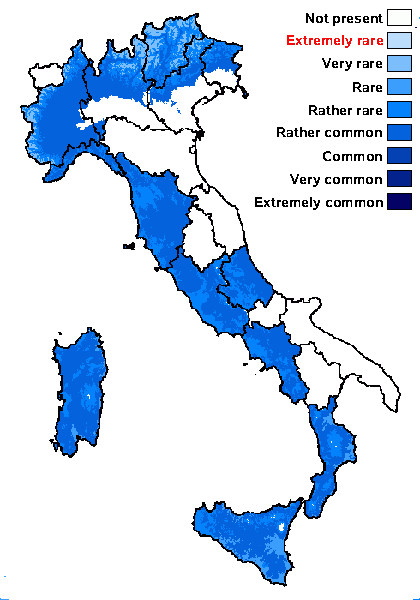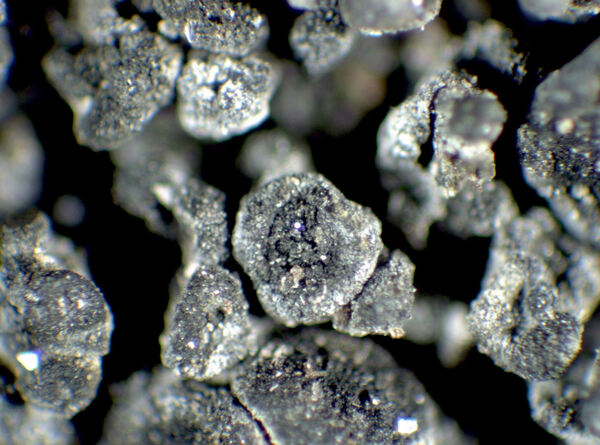Peccania coralloides (A. Massal.) Arnold
Flora, 41: 93, 1858. Basionym: Corinophoros coralloides A. Massal. - Flora, 14: 213, 1856.
Synonyms: Omphalaria coralloides (A. Massal.) Hepp
Distribution: N - VG, Frl, Ven (Lazzarin 2000b, Nascimbene 2005c, 2008c, Nascimbene & Marini 2007), TAA (Spitale & Nascimbene 2012, Watson 2014, Nascimbene & al. 2022), Lomb, Piem (Isocrono & al. 2004), Lig. C - Tosc (Benesperi 2000a), Laz, Abr (Nimis & Tretiach 1999, Gheza & al. 2021), Sar. S - Camp (Aprile & al. 2003, Nimis & Tretiach 2004, Garofalo & al. 2010), Cal (Puntillo 1996), Si (Nimis & al. 1994).
Description: Thallus minutely fruticose, subgelatinous when wet, forming up to 2(-2.5) cm wide and to 1.5 cm tall coralloid pillows, black but sometimes blue-grey pruinose when dry, dark olivaceous brown when wet, attached by bundles of rhizohyphae. Branches subcylindrical to rarely weakly flattened, erect, irregularly dichotomously branched, ecorticate, the peripheral part 75-150 μm thick, with a loose network of anticlinally oriented hyphae enclosing the photobiont, the inner part with an irregular, up to 500 μm thick axial strand made of 3-5 μm thick, longitudinally oriented hyphae, most evident near the base. Apothecia terminal, 0,5-1 mm across, at first urceolate, then clearly lecanorine, with a concave to flat, black to dark brown, often pruinose disc and a thick thalline margin. Proper exciple absent or very poorly developed; epithecium scarcely differentiated from the hymenium, patchily reddish brown to dark brown due to ascus walls decaying after spore discharge, K+ brown-purple, rarely K-; hymenium colourless to patchily brown in upper part, K/I+ deep blue, 100-120 μm thick; paraphyses branched and anastomosing, hardly constricted at septa, weakly or non-capitate; hypothecium yellowish brown, 30-60 μm high. Asci 8-spored, cylindrical-clavate, prototunicate, with a thin, one-layered, non-amyloid wall and an amyloid outer cap, the spore discharge passive, via apical rupturing. Ascospores 1-celled, hyaline, globose to broadly ellipsoid, 8-15 x 6-10 μm. Pycnidia terminal or marginal, immersed, globose to pyriform, 300-500 μm across, with colourless, not convoluted walls, the conidiophores terminally branched, with elongated cells. Conidia 1-celled, hyaline, thread-like, irregularly curved, 20-40 x c. 1 μm. Photobiont cyanobacterial, chroococcoid, with single or paired 8-15 x 7-11 μm large cells often penetrated by haustoria, surrounded by a yellowish brown gelatinous sheath which tends to become thinner and paler in internal parts. Spot test: all negative. Chemistry: without lichen substances. Note: on steeply inclined, usually south-exposed seepage tracks of calciferous rocks, with a wide altitudinal range; certainly widespread throughout the country, but much overlooked.
Growth form: Fruticose
Substrata: rocks
Photobiont: cyanobacteria, coccaceous (e.g. Gloeocapsa)
Reproductive strategy: mainly sexual
On otherwise dry surfaces with short periods of water seepage after rain
Commonnes-rarity: (info)
Alpine belt: very rare
Subalpine belt: rather rare
Oromediterranean belt: absent
Montane belt: rather rare
Submediterranean belt: rather common
Padanian area: absent
Humid submediterranean belt: rather common
Humid mediterranean belt: rather rare
Dry mediterranean belt: rare

Predictive model
Herbarium samples
Growth form: Fruticose
Substrata: rocks
Photobiont: cyanobacteria, coccaceous (e.g. Gloeocapsa)
Reproductive strategy: mainly sexual
On otherwise dry surfaces with short periods of water seepage after rain
Commonnes-rarity: (info)
Alpine belt: very rare
Subalpine belt: rather rare
Oromediterranean belt: absent
Montane belt: rather rare
Submediterranean belt: rather common
Padanian area: absent
Humid submediterranean belt: rather common
Humid mediterranean belt: rather rare
Dry mediterranean belt: rare

Predictive model
| Herbarium samples |
 Index Fungorum
Index Fungorum
 GBIF
GBIF




